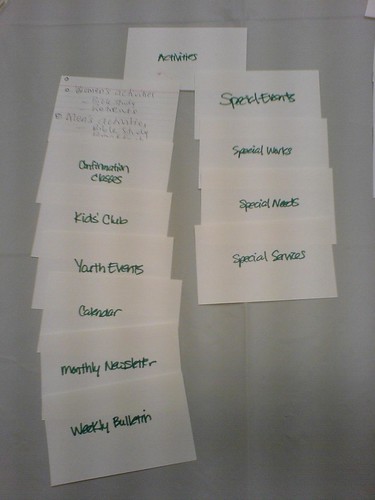What is a Card Sort?
Card Sorting is a method or technique for discovering how website users categorize information so that you can design your information structure in a way which is navigable and findable by your users. The method involves asking participants to sort sets of cards which have items, names, pages, or sections of your website printed on them into groups that make sense to them, and sometimes to assign labels to those groups.

What a Card Sort Can Provide
"Card sorting studies can provide insight into users' mental models, illuminating the ways they often tacitly group, sort, and label tasks and content within their own heads" - Information Architecture for the World Wide Web.
- Input into a website's organizational structure
- Suggestions for navigational systems, menus, and taxonomies
- Identify problem or misunderstood areas of your website
- Insight into organizational trends such as whether users prefer to organize your information by format, subject, task, or business group
Different Types of Card Sorts
An Open Card Sort is one in which participants are given a stack of cards, each with website items printed on them, and are asked to sort them into piles of items which seem to belong together. They are also asked to describe each of these piles by writing labels on blank cards and assigning them to card groups.
- Open card sorts are useful at the outset of a new website or redesign project
- They are great discovery tools
A Closed Card Sort is one in which participants are given both the stack of cards and a group of labels and must sort the cards into these existing categories. These pre-existing labels may be from an established website, or may have been gleaned from an open card sort which was previously given.
- Closed card sorts are useful when you feel that you already have the most effective labels for your website content, yet want to test them out
- They are great tools for validation
Card Sort Variations - Card sorts can be varied and adapted for particular needs, it isn't necessary to keep strictly to this formula for instance, additional tasks may be added such as user surveys, questions about particular terms, or tasks such as asking participants to set aside cards which they feel should be on the front page, or requesting that participants organize their groups of items into content trees with items placed in a structured order.
Online vs. Live Card Sorting is a matter of taste and what you have the capability of doing. Live card sorts are very low-tech, cost-efficient, and easy to prepare for, however, involve recruiting volunteers to physically come to a testing site as well as the time commitment of the card sort administator to hold each study. However, participants do have the opportunity to ask questions during a live card sort and administrators have the opportunity to listen in on participant discussions which can yield additional insight. Online card sorts can cost money depending on which tool you choose, however, they are quite easy to prepare for and do not require any time commitment from an administrator to give the study - volunteers can sign on and take the test themselves without needing to physically come to a testing site.
Holding Individual vs. Group Card Sorts is also a matter of preference as well as the availability of volunteers to partake in the sorts. Having groups conduct card sorts has the advantage sparking conversations between participants. Observing administrators will be able to make note of the points raised during these informal chats which can provide additional insight into the information design process. A disadvantage, however, is that a group consensus is usually reached to complete the sort which may discount some individual's mental models of information organization and can be counter-productive for this task.
Comments (0)
You don't have permission to comment on this page.